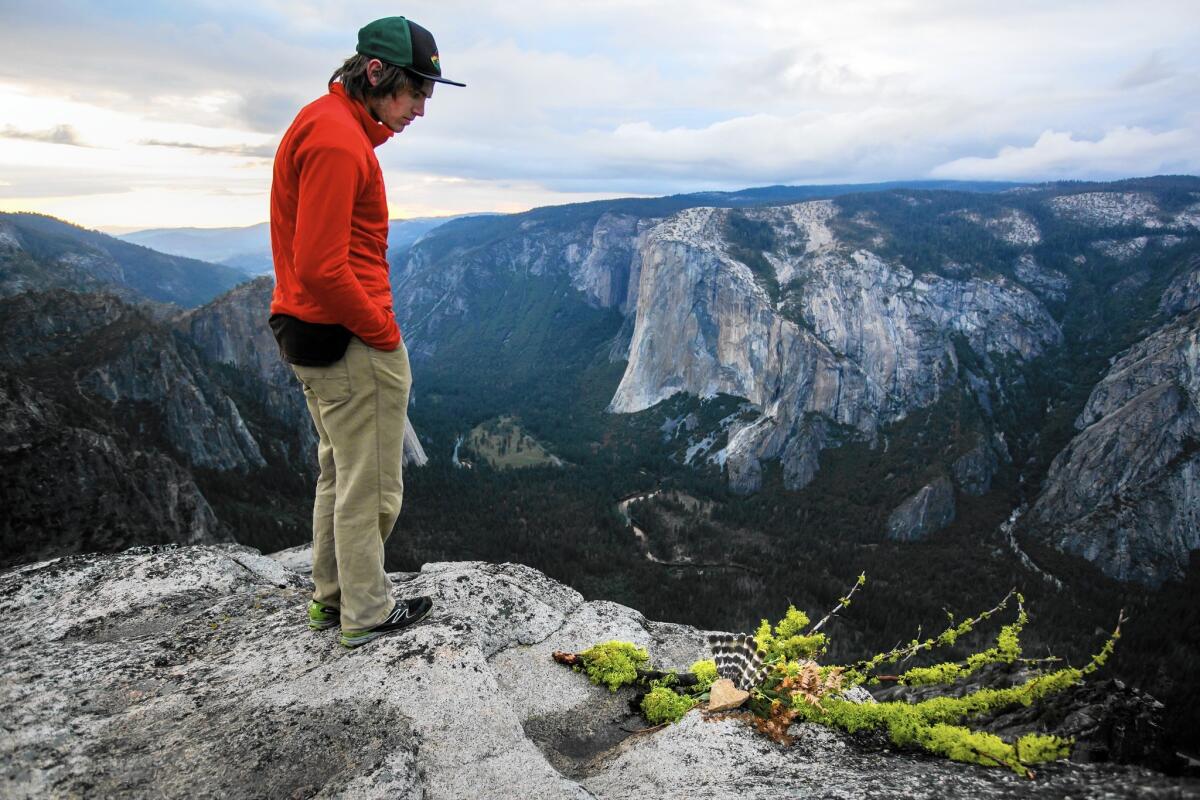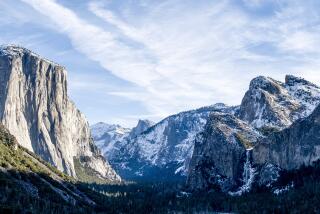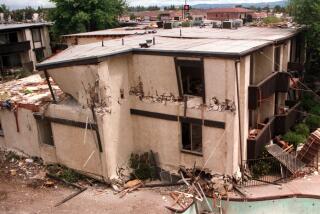Yosemite BASE jumper was attuned to the flutter of a butterfly

Stepping off Taft Point on the evening of his death, Dean Potter tensed his body and set a trajectory through the sky above Yosemite Valley.
He measured time — three seconds of free fall — before the baffles of his wingsuit inflated, and the resistance of his body against the air pushed back against the force of gravity.
Far below, the dogwoods were blooming, the meadows alive with the rush of spring. In the distance were the sweeping face of El Capitan and the cascade of Yosemite Falls.
Just ahead, less than a quarter mile and 1,500 feet below, was a rocky ridge behind the cliff known to climbers as the Lost Brother, and, in the ridge, a U-shaped notch, 200 feet wide at the top tapering to 30 feet at the bottom, that the 43-year-old Potter hoped to thread.
Behind him, by just a second, flew Graham Hunt, 29, a blond-haired prodigy not unlike Potter at that age. They had honed their skills flying together in Europe, and now, back in the valley, they were happy to explore one of the world’s premier destinations for their sport.
On Taft Point was Potter’s girlfriend, Jen Rapp, shooting with her Canon, documenting this flight frame by frame. A friend looking at the photos the next day described the flight to The Times.
Conditions were fine at 7:30 p.m. on May 16. The sun had not yet set and the light was flat, just enough to see where they needed to go and yet not enough to be seen by the rangers, who are quick to enforce the ban on BASE jumping in the park.
With the wind sweeping over him, an eddy and a vacuum forming on his back, Potter began to accelerate forward as he fell, his senses undoubtedly quickened.
Potter had courted this feeling all his life, friends say, as a solo climber and a high-line walker, tight-roping across chasms on a thread. Unlike other climbers who worked rock faces quietly like machines, Potter was known for his grunts and shouts.
His senses were so attuned to the moment that he could sense the smallest disturbance around him — even, as legend has it, the flutter of a butterfly lazily scalloping the air behind his back.
“I love the idea that I can change the worse possible thing to the best possible thing,” he once said. “Dying to flying.”
::
Yosemite had been Potter’s playground since he arrived here in 1993.
Born in the flatlands of Kansas, he told journalists that he learned discipline from an Army father and focus from a yoga-practicing mother.
At the age of 5, as he writes on his website, he fell from the roof of his house and in the process lost his fear of heights. Ten years later he was climbing the cliffs of New England, where he attended high school and college before dropping out.
By the mid-1990s, climbing culture in the valley was in the midst of its generational change. Gone were the wild-eyed hipsters from the ‘60s such as Yvon Chouinard and Royal Robbins. Gone were the doper-climbers who followed, the ones who called themselves the Stonemasters.
One man remained, Charles Victor Tucker III, the keeper of the tales. Better known as Chongo, Tucker had a knack for evading authorities and a reputation for expounding on quantum physics and for spending weeks on remote ledges high above the valley.
Chongo taught Potter to walk a slack line and to live homeless while assailing El Capitan and Half Dome with and without ropes.
Soon Potter and other climbers formed the core of the park’s notorious underground, the Stone Monkeys, a rebellious crew whose affection for the local granite was as keen as their disdain for the rules and regulations that governed life in the national park.
Whereas the Stonemasters helped immortalize Yosemite’s famed campground, Camp 4, as hallowed ground for assaults on El Capitan, the Monkeys avoided it. Too many rangers and too many sycophants had soured the vibe.
Seeking out caves and meadows for overnight stays and cadging food from the cafeteria at Yosemite Lodge, the Monkeys — a crew of no more than 15 — flew under the radar and practiced a buccaneer-like irreverence to climbing.
They made Yosemite their home. Their living room was the public amphitheater at the lodge. Their office was a nearby clearing.
And their sanctuary was the Tree, an aged Douglas fir in Leidig Meadow, where they gathered, shared the occasional spliff and practiced balancing on ropes drawn between trees.
It was here — as the story goes — that Potter first felt the butterfly’s winged breath on the back of his neck as he walked on the tightly strung line. It was a distraction, something he would have to practice putting out of his mind.
“He was so attuned to his environment in those moments that he could feel what he couldn’t see,” said Potter’s friend, Dean Fidelman, who witnessed the butterfly moment. “But it can be hard to handle. You’re so alive.”
Fidelman remembers the moment Potter decided to take up BASE jumping. In 2003, he was on an ascent of Half Dome when he heard something rustling nearby. He looked over his shoulder and saw two jumpers drifting by on their chutes. Potter never liked the trudge down from a climb, and this new mode of descent made sense.
He learned to sky-dive in Colorado and BASE jump in Idaho. He brought his skills back to the park, where the prohibition only added to the allure.
Fidelman was a part of Potter’s ground crew, riding his bike in the dawn hours and twilight to make sure the rangers weren’t around, passing along the news by radio.
“We were riding in packs, and if we saw rangers we’d run and hide,” Fidelman said. “It was like being 13 again.”
Soon other climbers joined the fun, and the Realm of the Flying Monkeys was established.
::
Potter was on line, perhaps a little low, but still on a straight track for the notch in ridge, Fidelman said.
Closing in, Potter tucked his chin into his chest, gaining speed and tracking the granite slabs below.
Beyond the notch lay the grand yaa-hoo, the moment of celebration some 500 feet above the valley floor when the chute filled and a landing spot lay ahead: a sandbar in the Merced River or a meadow down from Camp 4. Then followed the manic evasion, scooping up the chutes and disappearing into the forest.
No one knew BASE jumping in Yosemite better than Potter, and he and Hunt had flown this route before. Taft Point was a half-hour drive from Potter’s home in Yosemite West, reached via a pull-off just before Glacier Point. The exit, their takeoff point, was a mile and a half walk through the woods, 3,500 feet to the valley below.
In their wingsuits — custom-made nylon that spanned a gap between their legs and between their torsos and arms — they looked like flying squirrels.
They favored what is known as proximity flying, angling themselves as close as possible to the cliffs to best capture the sensation of speed. To fly as a pair added another element of thrill.
Friend and climber Cedar Wright described Potter as both a gladiator and a monk, a ferocious perfectionist who knew the odds. Just last year, Potter had lost a best friend in a BASE jumping accident in Zion National Park. Sean Leary’s death only confirmed Potter’s commitment to make the sport more safe.
This month, he was to be honored as “a climber, line walker and human-body flier” at a special dinner in New York by the choreographer Elizabeth Streb, who since 2006 has celebrated the work of “transgressive action specialists whose seemingly reckless journeys are, in reality, a society’s insignia for bravery and courage.”
Potter relished the recognition, Fidelman said. Potter had committed his life to endeavors that were both competitive and dangerous. There were times when he had his doubts.
Not long ago, according to Fidelman, Potter had lost his way. His wife had left him. Close friends had died in climbing accidents. Sponsors bailed after he climbed — some say defiled — Utah’s state symbol, Delicate Arch. The park service continued its clampdown, the Monkeys claim, towing cars and employing night-vision goggles to ferret out illegal campsites.
Fidelman felt that BASE jumping helped Potter keep his focus, and in time it gave him new goals: establishing a community outside of the park for a new generation of Monkeys and finding a way to land without the aid of a parachute.
::
The cliffs of Yosemite have always invited risk takers. Black-and-whites show women in bloomers high-kicking above precipices, and visitors today dangle their feet for selfies. Tempting fate is another way to feel alive.
But BASE jumping is more than tempting fate. It is a dance with fate, arm in arm, wind and gravity — and, when the chute opens, a polite bow until the music plays again.
The National Park Service, however, is clear in its prohibition of the sport.
“BASE jumping is illegal,” said Yosemite spokesman Scott Gediman, who cites a federal regulation — 36 CFR 2.17 — outlawing “delivering or retrieving a person or object by parachute, helicopter or other airborne means, except in emergencies.”
When caught, BASE jumpers face a fine, possible jail time and the confiscation of their equipment. But it is the nature of the sport — and its devotees — that such terms are scarcely a deterrent.
Park policy has forced jumpers only to be more discreet in the pursuit of their sport — and, as Gediman admits, it’s hard to stop them. Yosemite has 750,000 acres, more than 4 million annual visitors and fewer than 100 rangers who can enforce the park’s rules.
Jumpers cite libertarian values and question why other risky behaviors are not ruled out: speed climbing without ropes, high lining thousands of feet above the valley.
They also believe that the policy against BASE jumping only makes these accidents inevitable.
Rather than provide a safe environment in one of the world’s best locations for the sport, jumpers have to resort to late or early hours when the lighting is less than optimal.
Plus, says Cedar Wright, the challenge of the sport is made more difficult when jumpers have to factor in the prospect of getting caught.
“He was a great guy,” said photographer and blogger Tom Evans, who knew Potter for 20 years. “But it’s not unexpected. When you’re out on the front edge, you’re going to get cut.”
::
Within seven seconds of their jump, speeds approached 100 mph. Hunt made a course correction, Fidelman said. Flying behind Potter’s right shoulder, he crossed above to Potter’s left.
No one was sure why Hunt altered his course. Perhaps he felt he wasn’t on line to make it through the notch. Perhaps he realized that there wasn’t going to be room for both of them in that narrow space.
But the moment that he crossed over, the delicate dynamic of their flight changed.
Some wondered if the air flowing off Potter’s suit disrupted the air that Hunt was channeling for his flight.
Suddenly Hunt veered fatally to the right.
Some wondered if Potter caught a similar disturbance off Hunt’s suit. There is no way to tell.
But for Fidelman, one thing is clear.
“Dean felt the butterfly behind his head.”
Twitter: @tcurwen
More to Read
Start your day right
Sign up for Essential California for news, features and recommendations from the L.A. Times and beyond in your inbox six days a week.
You may occasionally receive promotional content from the Los Angeles Times.







